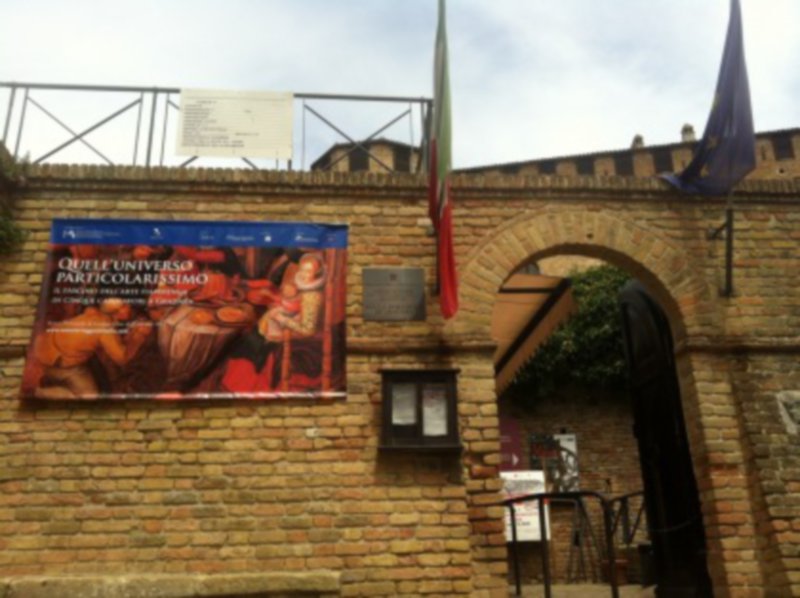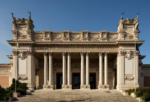Quell’universo particolarissimo

Le suggestive sale della Rocca accoglieranno cinque straordinarie opere legate alle personalità più rappresentative della pittura fiamminga del XV e XVI secolo: Rogier Van der Weyden, Adriaen Isenbrandt, Pieter Brueghel il Giovane, Ambrosius Benson e Joachim Patinir.
Comunicato stampa
Marche
Gradara, Rocca di Gradara
Quell’universo particolarissimo:
il fascino dell’arte fiamminga in cinque capolavori a Gradara
15 giugno – 29 ottobre
Seconda tappa del viaggio lungo la penisola sarà l’incantevole Rocca di Gradara, uno dei monumenti più visitati delle Marche. Il castello, che sorge su una bellissima collina, ospitò le principali famiglie dell’epoca medievale e rinascimentale e fu teatro di grandi eventi storici e leggendari, tra cui anche la celebre storia d’amore tra Paolo e Francesca.
Le suggestive sale della Rocca accoglieranno cinque straordinarie opere legate alle personalità più rappresentative della pittura fiamminga del XV e XVI secolo: Rogier Van der Weyden, Adriaen Isenbrandt, Pieter Brueghel il Giovane, Ambrosius Benson e Joachim Patinir.
L’arte di Rogier Van der Weyden, figura chiave della pittura del XV secolo non solo nelle Fiandre ma anche per l’influenza delle sue opere su quelle italiane, sarà mostrata al pubblico attraverso il celebre dipinto attribuitogli Madonna con il Bambino che, attraverso la qualità grafica del tessuto arabesque e grazie alla costruzione consapevolmente orchestrata quasi scolpita degli elementi, riesce a trasmettere un’intensa spiritualità.
Stessa atmosfera si respira nell’omonima opera di Adriaen Isenbrandt che, nel costruire la composizione con un inedito senso di leggerezza, rivela per contro la chiara influenza dello stile italiano, e in particolare quello di Leonardo da Vinci, che addolcisce gli elementi più rigorosi e formali del dipinto. Insieme a Isenbrandt, Ambrosius Benson è considerato non solo uno dei pittori più maturi che operò a Bruges – città maggiore delle
Fiandre occidentali – ma anche uno dei più noti ritrattisti della tradizione fiamminga come dimostra Ritratto di uomo con un libro, dipinto selezionato per questa sede.
Lo splendido Scena di locanda offrirà, invece, ai visitatori uno straordinario esempio della pittura di genere fiamminga di Pieter Brueghel il Giovane, il quale, ponendo straordinaria attenzione ai dettagli, rappresenta una scena di vita quotidiana ambientata in una locanda, tematica piuttosto ricorrente nei suoi lavori. Le sale della Rocca di Gradara avranno l’onore di ospitare anche San Girolamo un’opera molto suggestiva di Joachim Patinir, uno dei primi artisti fiamminghi che si specializzò nella rappresentazione delle vedute paesaggistiche: sullo sfondo uno scenario quasi visionario è realizzato attraverso la combinazione fantasiosa di dettagli realistici.
Orari di Apertura
Lunedì dalle ore 8.30 alle ore 14.00
Da Martedì a Domenica – Festivi compresi dalle ore 8.30 alle ore 19.15
La biglietteria chiuderà alle ore:
Da martedì a Domenica e Festivi ore 18.30
Lunedì ore 13.15
Biglietti
Intero: €.4,00
Ridotto: €. 2,00 (Per tutti i cittadini dell’Unione Europea di età compresa tra i diciotto ed i venticinque anni, per i docenti con incarico a tempo indeterminato delle scuole statali, per i cittadini tra i 18 e i 25 anni non facenti parte dell’Unione Europea a condizione di reciprocità nella riduzione)
Ingresso gratuito: Per i cittadini italiani che non abbiano compiuto il 18° anno di età o che abbiano compiuto il 65°, per i dipendenti del Ministero dei Beni Culturali e Ambientali, Guide ed Interpreti turistici, membri I.C.O.M., docenti e studenti di Architettura, Lettere, Conservazione B.C., Accademie Belle Arti, ecc., per i cittadini stranieri che non abbiano compiuto il 18° anno di età o che abbiano compiuto il 65°, a condizione di reciprocità nella gratuità.
sito ufficiale della Rocca di Gradara
Second stage of the journey along the peninsula is the beautiful fortress of Gradara, one of the most visited Marche’s monuments. The castle, which sits on a beautiful hill, housed the greatest families of the medieval age and of the Renaissance period and was the scene of major historical events and legends, including the famous love story between Paolo and Francesca.
The impressive rooms of the Rocca will host five extraordinary works related to the most prominent protagonists of the fifteenth and sixteenth centuries Flemish painting: Rogier van der Weyden, Adriaen Isenbrandt, Pieter Brueghel the Younger, Ambrosius Benson and Joachim Patinir.
Rogier van der Weyden, key figure iof the fifteenth century painting ,not only in Flanders but also for the influence of his works on Italian ones, will be shown to the public through the famous painting Madonna and Child that through the arabesque fabric graphic quality and the almost consciously sculpted elements, is capable to inspire an intense spirituality.
You can breathe the same atmosphere in the work by Adriaen Isenbrandt that, thanks to a composition that reveals an unprecedented sense of lightness, also shows the clear influence coming from the Italian style, and particularly from Leonardo da Vinci, who softens the most formal and hardest elements of the painting. Along with Isenbrandt, Ambrosius Benson is not only considered one of the most mature painters who worked in Bruges – the major city of Flanders – but also one of the most famous portrait painters of the Flemish tradition, as Portrait of a Man with a book, painting selected for this site, underlines.
The splendid Scene at the inn will offer, however, the visitors an extraordinary example of Flemish genre painting by Pieter Brueghel the Younger, who, with extraordinary attention to the details, represents a scene of everyday life set in an inn, frequent theme in his works. The halls of the Fortress of Gradara will have the honor to host also a very impressive work by Jerome Joachim Patinir, one of the first Flemish artists who specialized his production in landscape views: in the background a visionary scenario is realized by combining imaginary and realistic details.
Opening hours
Mondays 8.30 am – 2 pm
From tuesdays to sundays 8.30 am – 7.15 pm
Mondays ticket office closes at 1.15 pm
From tuesdays until sundays ticket office closes at 6.30 pm
Ticket fees
Full price: € 4,00
Reduced ticket: € 2,00
for European citizens aged 18 to 25 with identification document, European permanent state teachers, non-European citizens aged 18 to 25 with identification document only when reduction is mutual
Free entrance for italian citizens under 18 or over 65, Employed for the Ministry of Culture and Heritage, Members of the ICOM (International Council of Museums), European teachers and students from the school of architecture, preservation of the cultural heritage, etc etc, Tour guides and Intepreters, non-European citizens under 18 and over 65 when the free entrance is mutual.



